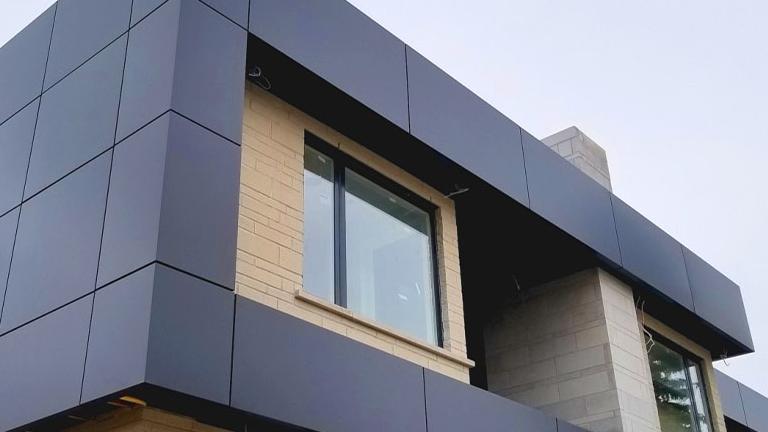
ADTO News
Ensuring Safety When Using Aluminum Wall Panels in Construction
Aluminum wall panels are an essential element in modern construction, offering a combination of lightness, strength, and aesthetic appeal. From creating sleek, modern facades to serving as durable interior walling, these panels are versatile and widely used in both residential and commercial construction. However, as with any construction material, safety during installation, maintenance, and inspection is crucial to avoid accidents and ensure the longevity of the structure.

Handling and Installation Safety
While aluminum panels are generally lightweight compared to other materials like steel or concrete, they still require careful handling due to their size and shape. When moving panels around a site, it’s vital to use proper lifting equipment such as cranes, hoists, or forklifts, especially for larger panels. Even when panels are handled manually, workers should ensure that they have a secure grip and use lifting techniques that avoid straining the body. A team of workers is often necessary to ensure the panels are lifted safely and properly positioned.
For installation, the use of scaffolding or elevated work platforms is essential to ensure workers can safely access the height required for attaching the panels. Scaffolding should be secure, level, and constructed to bear the weight of workers, tools, and the panels. Safety rails and non-slip flooring are also critical to prevent falls and other accidents.
Cutting and Modifying Aluminum Panels
While pre-fabricated aluminum panels often come with standard dimensions, custom cutting may be necessary for particular projects. When cutting aluminum, it’s important to use the right tools designed specifically for metalworking, such as a circular saw with a carbide-tipped blade or specialized aluminum cutters. Always ensure that the work area is well-ventilated, as the cutting process can produce sharp edges and metal dust that can be hazardous if inhaled.
In addition to using the right tools, wearing appropriate protective equipment such as safety glasses, gloves, and hearing protection is essential. Workers should also use clamps to secure the panels in place while cutting to prevent any shifting or movement that could cause accidents.
Maintaining and Inspecting Aluminum Wall Panels
Aluminum wall panels are known for their resistance to corrosion and weathering, making them ideal for both indoor and outdoor use. However, regular maintenance and inspection are key to ensuring they perform optimally throughout their lifespan. Over time, panels may accumulate dirt, dust, or pollutants from the environment, especially if they are installed on the exterior of a building.
To clean aluminum panels, use mild soap and water, along with a soft cloth or sponge. Avoid harsh chemicals or abrasive materials, as these can scratch or dull the surface of the panels. For high-rise buildings or difficult-to-reach panels, a pressure washer with a low-pressure setting can also be used to remove buildup without causing damage.
Inspection should focus on checking for any signs of wear and tear, particularly in areas exposed to the elements. Look for any loose fasteners, warped or dented panels, and areas of corrosion, particularly along the edges or corners. If panels are subjected to frequent temperature changes, expansion and contraction can sometimes cause them to loosen or shift over time. Any panels that show significant signs of damage should be promptly repaired or replaced to avoid further issues.
Safety Measures During Ongoing Maintenance
Aluminum panels often require periodic maintenance to keep them looking and performing at their best. During maintenance activities such as repainting or re-coating, it’s important to use scaffolding or ladders to reach higher areas. Workers should also be sure to wear the appropriate PPE, including fall protection gear when working at height.
When applying new finishes or protective coatings to aluminum panels, always use paints and coatings designed specifically for metal surfaces to ensure adhesion and longevity. Ensure that the work area is well-ventilated, particularly when using aerosol-based sprays or chemicals.
Ensuring Structural Integrity with Proper Installation and Maintenance
The integrity of the structure depends heavily on how well the aluminum panels are installed and maintained. Properly installed panels should be securely fastened, level, and aligned to provide both aesthetic appeal and protection. Any gaps or misalignments could allow water to seep behind the panels, leading to long-term damage such as corrosion, rot, or mold.
Incorporating Safety Standards into Every Stage of Construction
In addition to the safety considerations for installation and maintenance, it's essential that all aluminum wall panel installations comply with local safety standards and regulations. This includes ensuring that installation methods, equipment, and safety protocols meet the required standards set forth by governing bodies such as OSHA or equivalent local agencies.
Training workers on the proper installation techniques, safe handling, and inspection practices is essential to ensuring compliance with safety regulations. A well-trained workforce is key to preventing accidents and maintaining a high level of safety throughout the project.
Conclusion
Aluminum wall panels are a popular and reliable material choice in modern construction, offering both durability and aesthetic appeal. However, ensuring the safety of workers during installation and maintenance is essential to the success of any project. By following proper handling and installation procedures, maintaining the panels regularly, and adhering to local safety regulations, construction teams can maximize the benefits of aluminum wall panels while minimizing the risk of accidents.
For top-quality aluminum wall panels and expert advice on safe installation and maintenance practices, look to adtomall for your construction needs.


 Live Chat
Live Chat
